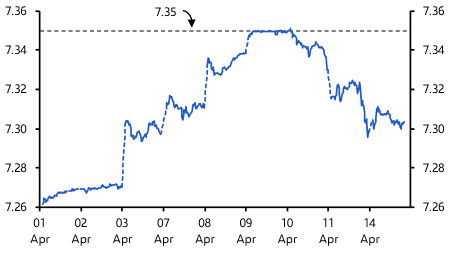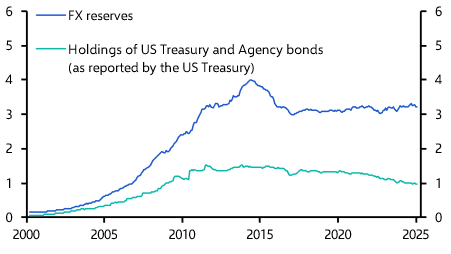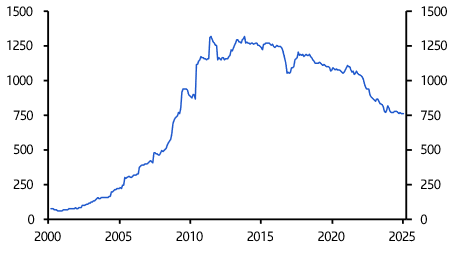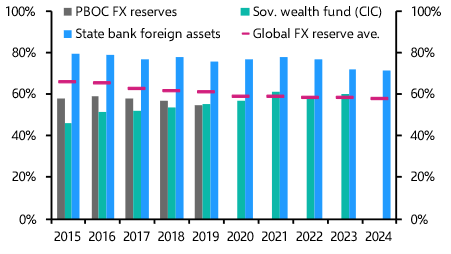- Available data don’t give a definitive answer to whether sales by Chinese institutions contributed to the recent volatility in the US bond market. But China’s state managers of foreign assets still appear to have more than half of their portfolios invested in US markets, despite the geopolitical pressures of recent years. That is because they don’t have attractive alternatives outside China, and certainly not at home. A fire sale of these assets would impoverish China more than it would hurt the US.
- It is not possible to rule out the suggestion that Chinese institutions were behind last week’s market moves but circumstantial evidence suggests otherwise. China’s reserve managers almost certainly were active in the market given the extent of the currency moves, but don’t seem to have been key drivers.
- The question of whether China’s holdings of US assets give it leverage is one that will reappear though, given strains between the two countries. China’s main state institutions own at least $3 trillion in dollar assets.
- That means that it is in China’s interests that their value is maintained. Deliberately precipitating a sell-off would be self-harming. About the only circumstance in which this might make sense would be if China believed that the US was about to freeze or default on its obligations to Chinese investors.
- China would have a dilemma over what to do with the proceeds if it divested on a large scale. Repatriate them and the renminbi would strengthen: not what China’s export sector needs during a trade war with the US. Channel them into developed markets other than the US and those countries’ government would protest as their currencies strengthened.
- And the damage to the US from any sell-off would be less than many suppose: as soon as any financial strains mounted, the Fed could step in as a buyer or last resort.
- A more prudent way of reducing dollar exposure would be to extricate assets gradually from US markets and trickle them into other markets. There is some evidence of this happening over recent years and it probably will continue.
- But the high share of China’s state-owned foreign assets in US markets is still striking. This reflects the weaknesses of alternatives: other Western markets are not havens from geopolitical risks; non-Western markets don’t provide safe and liquid reserve assets.
Is China offloading its dollar assets?
The surge in US yields and slump in the dollar last week has revived speculation of whether sales by China might be contributed to market moves and whether China’s asset holdings constitute a weapon that it can use against the US.
One seller among many
It is almost certain that China’s reserve managers were active in the market last week – whether the People’s Bank itself or the state-owned banks that act as the PBOC’s proxies. For one thing, the dollar experienced unusually severe swings and the PBOC sees part of its job as limiting volatility between the renminbi and the dollar.
There were signs in the intra-day data of periodic intervention – the renminbi lodged against a ceiling of 7.35 on Wednesday, for example. (See Chart 1.)
|
Chart 1: Intra-day CNYUSD Exchange Rate |
|
|
|
Sources: LSEG, Capital Economics |
This intervention could have been achieved by selling Treasuries and then converting the proceeds to renminbi, though that’s not how it would usually be done: reserve managers maintain a cash buffer for day-to-day intervention. And the sell-off was concentrated at the long-end. We don’t know for sure in China’s case, but a typical reserve manager would predominantly hold shorter-dated bonds.
In other words, it is likely that China sold dollars but China would have been one seller among many. After all, plenty of investors were reassessing their US exposure last week. There isn’t strong evidence that China or any central bank was a main driver of the moves.
Offloading dollar assets for the purpose of forcing US yields higher would be something quite different from regular currency market invention. It would be a marked change from the PBOC’s usual behaviour, exacerbating rather than damping exchange rate volatility.
And any suggestion that China was trying to weaponise its holdings of US assets would also be a major provocation. In the absence of evidence otherwise, it seems unlikely.
The borrower’s problem or the bank’s?
In practice, we think that China’s holdings of US assets give it much less leverage than many believe.
China’s total foreign assets amount to $9 trillion, a value equivalent to around half (52%) of China’s GDP. Just over half of them are in the hands of state institutions – the PBOC, sovereign wealth fund CIC and state-owned banks. (See Chart 2.)
|
Chart 2: China’s Foreign Assets (end-2024, excluding trade credit and receivables) |
|
|
|
Sources: CEIC, Capital Economics. Note: * CIC data are for end-2023 |
Most of these state holdings appear to be in dollar assets. The PBOC only releases details of its holdings with a five-year lag: 55% of the foreign exchange reserves were in dollar assets in 2019. CIC gives a breakdown of its public equity portfolio: 60% in US equities in 2023, which is almost exactly the 2023 share of MSCI USA in MSCI ACWI. 71% of the foreign assets owned by the state banks are dollar-denominated (and 93% of their foreign bonds). Adding these together, China’s main state institutions own at least $3 trillion in dollar assets.
This makes them beholden to the US, rather than the other way around.
It is in China’s interests that the value of its foreign assets doesn’t fall, whether as a result of lower US bond prices or a weaker dollar. Last week’s combination of both was a double whammy for foreign owners of US assets.
It’s also not clear that sales for the purpose of crashing bond prices would work if attempted on a large scale. There is, after all, no limit to the Fed’s capacity to buy dollar-denominated assets if it wants to. It could just step in and buy all of China’s assets at a modest discount: enough to force losses on China while preventing financial market dislocation. Other buyers might see an opportunity too.
A more aggressive response by the US would be to ban banks from transacting with Chinese entities, in effect freezing their holdings, as happened with Russian firms in 2022. That would be overkill if China were simply reallocating some of its portfolio but perhaps not if it was believed to be trying to tank the market. There might be spillovers across US markets. Would other investors see this as opening the door to further selective defaults? Or would they treat it as a special case like the Russia freeze, which might be accepted if China was perceived to have launched a financial war?
Where to put the proceeds?
Then there is the question of what China’s asset sellers would do with the proceeds of any large sale of dollar assets over a short period. If they were repatriated in a hurry, the renminbi would strengthen. Indeed, this would precipitate the very exchange rate move that the FX assets were originally acquired to prevent. Doing that now, with the export sector facing the onslaught of US tariffs would be an act of self-sabotage.
Alternatively, the proceeds could be channelled into foreign markets outside the US. Other major Western markets are not as deep as US markets but they could absorb significant flows. The rallies in the euro and yen point to this happening last week. But governments elsewhere would not welcome continued large-scale inflows from a single actor that pushed up currencies.
The only reason a fire sale could make financial sense would be if Chinese officials thought that the US government was about to freeze its assets or default on Chinese-owned bonds. In that case, China would be willing to take a loss rather than risk getting nothing.
In other circumstances, the more prudent option would be to extricate China’s foreign assets from US markets gradually. The US Treasury’s TIC data are consistent with that happening. China’s published holdings of US Treasuries and Agencies have been edging down for a decade now while the published value of its foreign exchange reserves has been edging up. (See Chart 3.) The value of outstanding Treasuries has risen over the same period, so China’s share of outstanding debt has fallen even more.
|
Chart 3: China’s Foreign Exchange Reserves & Reported Holdings of US Debt ($ trillion) |
|
|
|
Sources: CEIC, Capital Economics |
The pace of decline actually levelled off recently (see Chart 4) but that’s only because of the rise in bond prices last year. Data on the flow of net purchases show continued, steady sales. (See Chart 5.)
|
Chart 4: China’s Holdings of US Treasuries (as recorded in the TIC data, $bn) |
|
|
|
Sources: US Treasury, Capital Economics |
There are a couple of downsides to the TIC data though. The main one if we’re trying to interpret recent market moves is that the most recent figures are for January. The other is that the US Treasury data don’t give a full picture of China’s US holdings. The net sales figures in Chart 5 only cover long-term securities.
|
Chart 5: Cumulative Net Purchases of Long-term US Securities by China ($bn, Jan. 2023 = 0) |
|
|
|
Sources: US Treasury, Capital Economics |
More important, the TIC data only fully capture China’s official holdings at custodian banks in the US. Holdings in foreign custodial accounts, such as Euroclear in Belgium, won’t be fully captured. The TIC data don’t tell us whether China’s asset holders really are reducing their dollar exposure or simply trying to make it less visible.
There is good reason to think China has been using custodians outside the US (see here) perhaps because the PBOC doesn’t want it known how much it has invested in US government debt. As a result, even when we have the TIC release for April, it won’t give us an unequivocal answer about what China’s reserve managers were doing over the past few days.
Certainly, the available figures on the overall dollar exposure of the PBOC, CIC and commercial banks don’t suggest it has fallen any faster than the share of global foreign exchange reserves allocated to the dollar (although, as noted, the latest PBOC data is five years’ old). (See Chart 6.)
|
Chart 6: Dollar Share of China’s Foreign Assets |
|
|
|
Sources: SAFE, CIC, CEIC. IMF, Capital Economics. Note: Latest PBOC data are for 2019. |
On the face of it this is a puzzle. Tension with the US has escalated again recently but the view in Beijing has been that the US considers China an adversary for a decade now.
The freezing of Russian assets in 2022 gave China’s foreign asset managers an extra reason to place them beyond the US government’s grasp. But it also underlined how difficult that is in practice: Western governments coordinated their sanctions on Russia. There’s no guarantee that their markets would be a geopolitical safe haven.
In any case, even together, these other Western markets can’t match the US market’s size. The US accounts for 13% of global imports and 29% of global GDP. But its markets are home to 40% of the world’s outstanding bonds by value and 48% of the world’s listed equity.
The other option is to shift more assets into alternatives like EM sovereign debt and real assets. But this only makes sense for the portion of the portfolio that exceeds China’s perception of its foreign exchange needs. These aren’t typical reserve assets for good reason: they exhibit high exchange rate risk, default risk, can be illiquid, and have a tendency to sell off at times of market stress.
Few alternatives to the dollar
As long as the policymakers want to continuing managing the exchange rate, and we think they do, they have few alternatives to the Western markets.
China’s central bank, sovereign wealth fund and commercial banks have between then invested an amount equivalent to at least 16% of China’s GDP in US markets. A fire sale of these assets would be self-defeating. A gradual rebalancing away from the US is plausible but there are limits to how much China can channel elsewhere, whether into other developed markets or into unconventional assets. And a gradual shift would not by itself cause market stress in the US.





